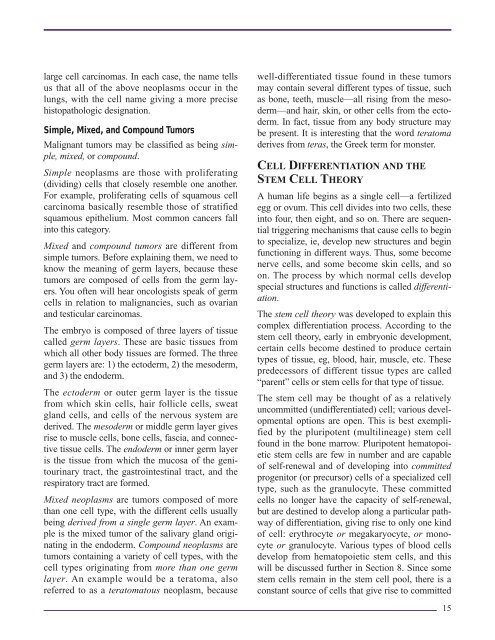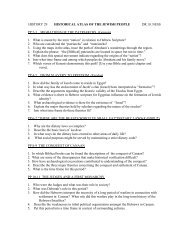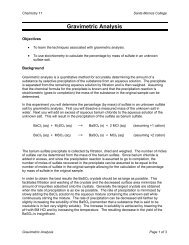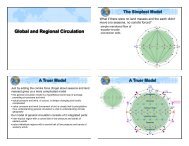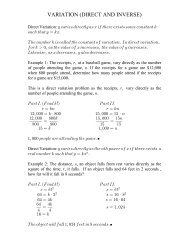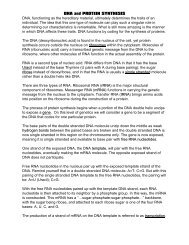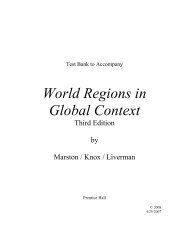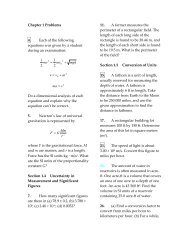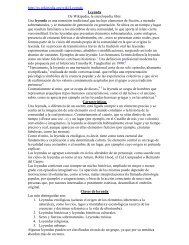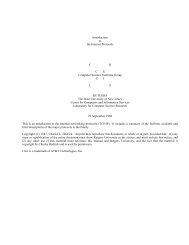Anaplasia/Dysplasia handout - read
Anaplasia/Dysplasia handout - read
Anaplasia/Dysplasia handout - read
Create successful ePaper yourself
Turn your PDF publications into a flip-book with our unique Google optimized e-Paper software.
large cell carcinomas. In each case, the name tells<br />
us that all of the above neoplasms occur in the<br />
lungs, with the cell name giving a more precise<br />
histopathologic designation.<br />
Simple, Mixed, and Compound Tumors<br />
Malignant tumors may be classified as being simple,<br />
mixed, or compound.<br />
Simple neoplasms are those with proliferating<br />
(dividing) cells that closely resemble one another.<br />
For example, proliferating cells of squamous cell<br />
carcinoma basically resemble those of stratified<br />
squamous epithelium. Most common cancers fall<br />
into this category.<br />
Mixed and compound tumors are different from<br />
simple tumors. Before explaining them, we need to<br />
know the meaning of germ layers, because these<br />
tumors are composed of cells from the germ layers.<br />
You often will hear oncologists speak of germ<br />
cells in relation to malignancies, such as ovarian<br />
and testicular carcinomas.<br />
The embryo is composed of three layers of tissue<br />
called germ layers. These are basic tissues from<br />
which all other body tissues are formed. The three<br />
germ layers are: 1) the ectoderm, 2) the mesoderm,<br />
and 3) the endoderm.<br />
The ectoderm or outer germ layer is the tissue<br />
from which skin cells, hair follicle cells, sweat<br />
gland cells, and cells of the nervous system are<br />
derived. The mesoderm or middle germ layer gives<br />
rise to muscle cells, bone cells, fascia, and connective<br />
tissue cells. The endoderm or inner germ layer<br />
is the tissue from which the mucosa of the genitourinary<br />
tract, the gastrointestinal tract, and the<br />
respiratory tract are formed.<br />
Mixed neoplasms are tumors composed of more<br />
than one cell type, with the different cells usually<br />
being derived from a single germ layer. An example<br />
is the mixed tumor of the salivary gland originating<br />
in the endoderm. Compound neoplasms are<br />
tumors containing a variety of cell types, with the<br />
cell types originating from more than one germ<br />
layer. An example would be a teratoma, also<br />
referred to as a teratomatous neoplasm, because<br />
well-differentiated tissue found in these tumors<br />
may contain several different types of tissue, such<br />
as bone, teeth, muscle—all rising from the mesoderm—and<br />
hair, skin, or other cells from the ectoderm.<br />
In fact, tissue from any body structure may<br />
be present. It is interesting that the word teratoma<br />
derives from teras, the Greek term for monster.<br />
CELL DIFFERENTIATION AND THE<br />
STEM CELL THEORY<br />
A human life begins as a single cell—a fertilized<br />
egg or ovum. This cell divides into two cells, these<br />
into four, then eight, and so on. There are sequential<br />
triggering mechanisms that cause cells to begin<br />
to specialize, ie, develop new structures and begin<br />
functioning in different ways. Thus, some become<br />
nerve cells, and some become skin cells, and so<br />
on. The process by which normal cells develop<br />
special structures and functions is called differentiation.<br />
The stem cell theory was developed to explain this<br />
complex differentiation process. According to the<br />
stem cell theory, early in embryonic development,<br />
certain cells become destined to produce certain<br />
types of tissue, eg, blood, hair, muscle, etc. These<br />
predecessors of different tissue types are called<br />
“parent” cells or stem cells for that type of tissue.<br />
The stem cell may be thought of as a relatively<br />
uncommitted (undifferentiated) cell; various developmental<br />
options are open. This is best exemplified<br />
by the pluripotent (multilineage) stem cell<br />
found in the bone marrow. Pluripotent hematopoietic<br />
stem cells are few in number and are capable<br />
of self-renewal and of developing into committed<br />
progenitor (or precursor) cells of a specialized cell<br />
type, such as the granulocyte. These committed<br />
cells no longer have the capacity of self-renewal,<br />
but are destined to develop along a particular pathway<br />
of differentiation, giving rise to only one kind<br />
of cell: erythrocyte or megakaryocyte, or monocyte<br />
or granulocyte. Various types of blood cells<br />
develop from hematopoietic stem cells, and this<br />
will be discussed further in Section 8. Since some<br />
stem cells remain in the stem cell pool, there is a<br />
constant source of cells that give rise to committed<br />
15


